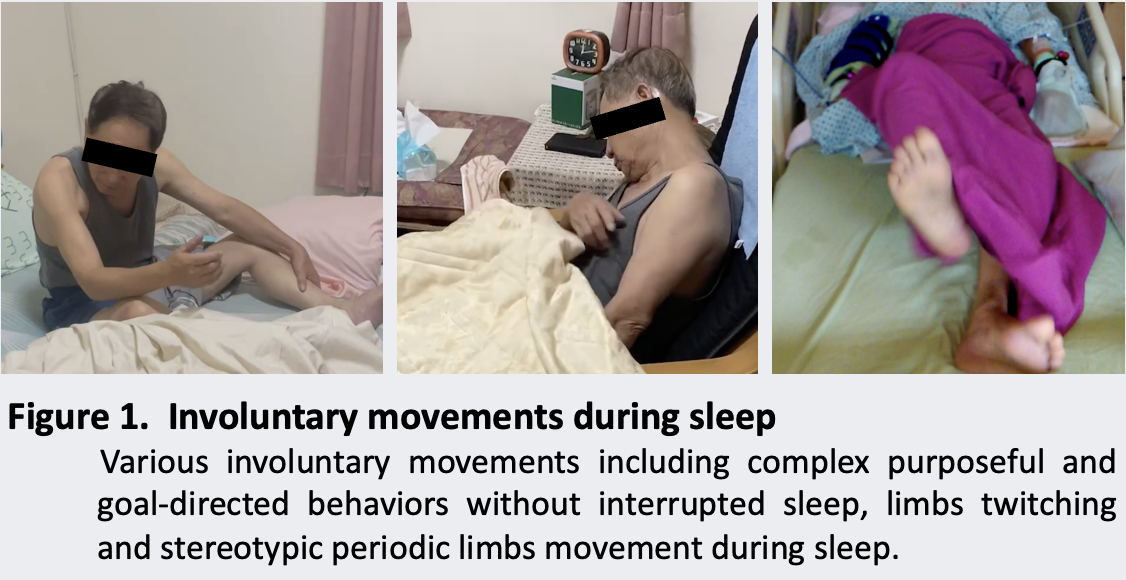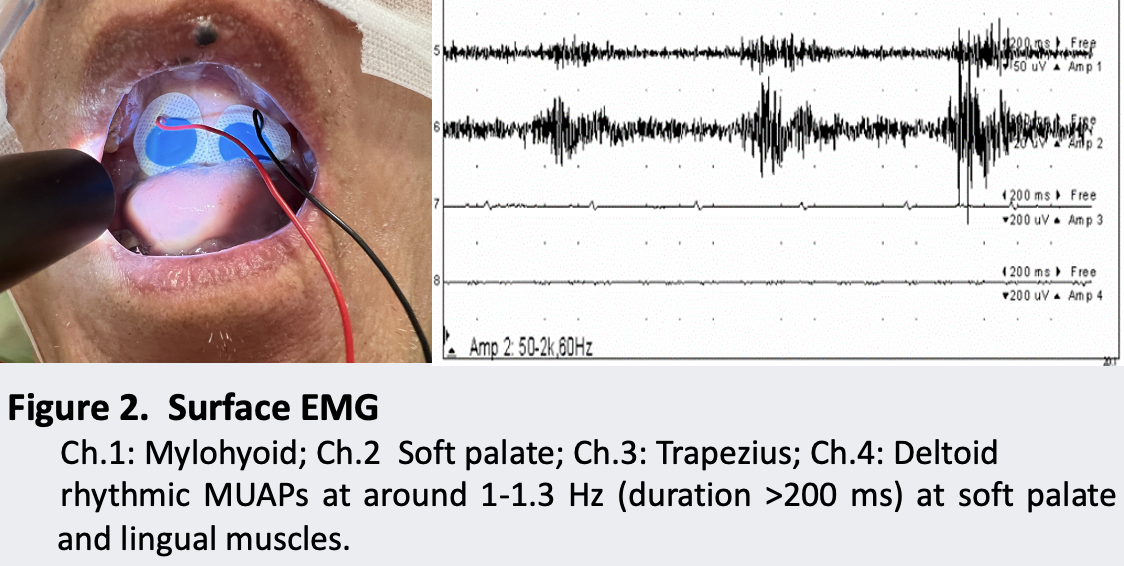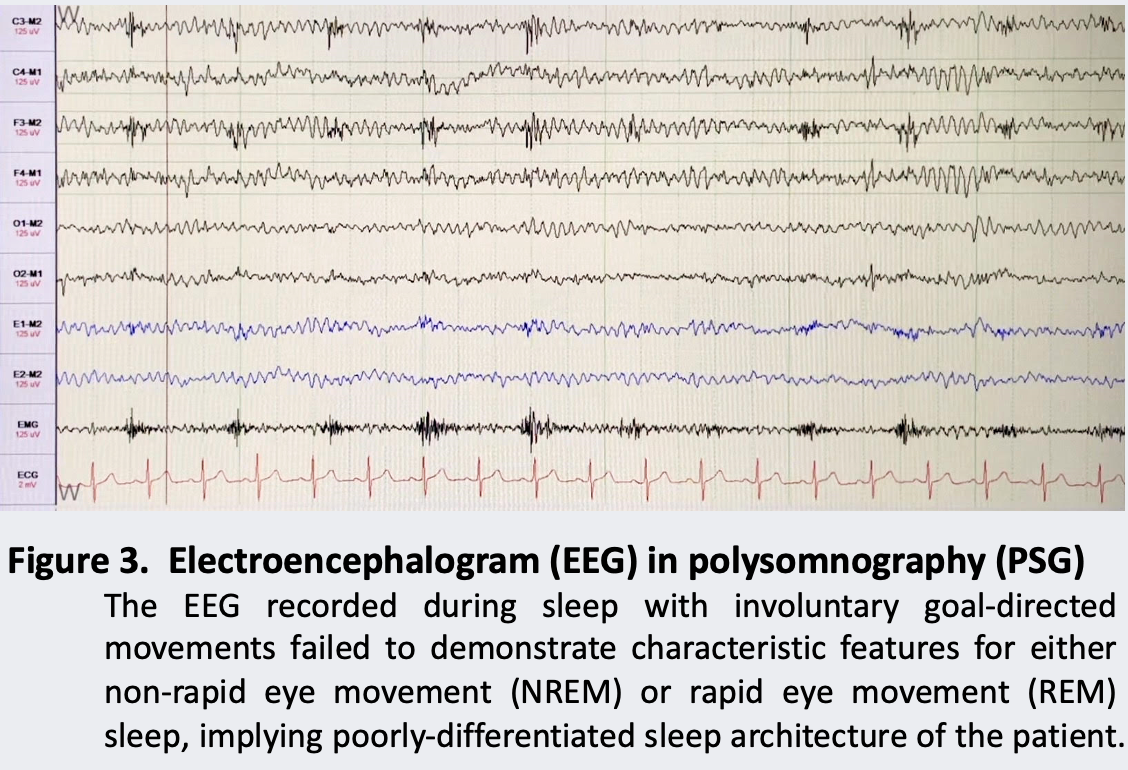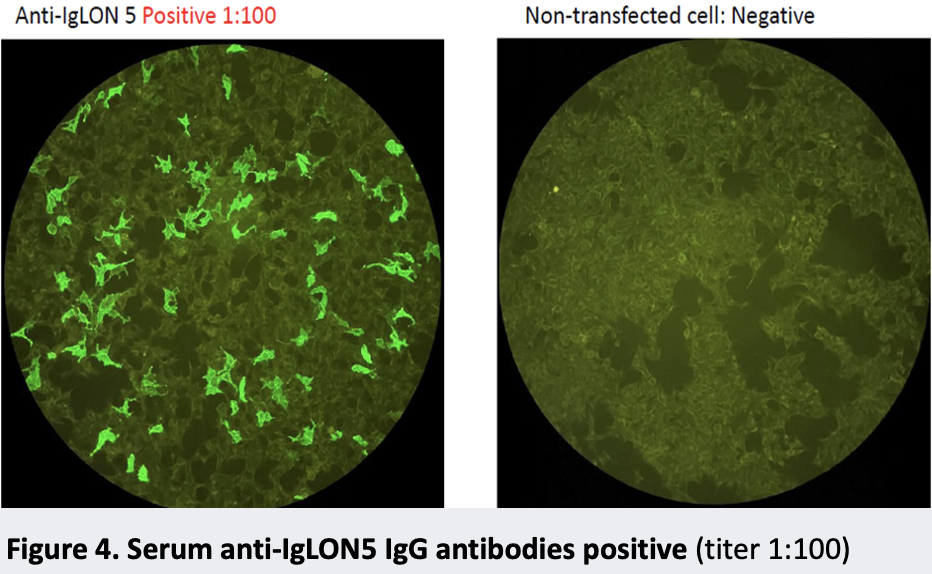Objective: Anti-immunoglobulin-like cell adhesion molecule-5 (anti-IgLON5) disease may manifest with spectrum of various neurological presentations and movement disorders, including prominent sleep movement disorders, bulbar symptoms, parkinsonism, and gait disturbances. Symptomatic myorhythmia and palatal tremor (PT) are commonly associated with lesions within the Guillain-Mollaret triangle. Here, we report a case with lingual-masticatory myorhythmia and palatal tremor as anti-IgLON5 disease diagnostic features.
Background: A 71-year-old man with underlying prostate cancer and lymphoid hyperplasia. He initially experienced acute binocular diplopia after receiving COVID-19 vaccination, followed by progressive postural dizziness, unsteadiness, hoarseness, and involuntary movements during sleep in the following 2 months. The neurological examination showed hypometric saccades with mild upward gazing limitation, dysarthric speech, left appendicular ataxia, and mild parkinsonism. However, his bulbar symptoms slowly deteriorated and he was hospitalized about 1 year later due to respiratory failure as a complication of aspiration pneumonia.
Method: Diagnostic work-up showed unremarkable findings of laboratory examinations, brain MRI, and Tc-99m TRODAT-1 scan. However, lingual-masticatory myorhythmia and palatal tremor were documented by surface EMG with rhythmic MUAPs at ~1Hz (duration >200 milliseconds). The Otolaryngology fibroscopy showed bilateral vocal cord paresis with atrophy. The video polysomnography revealed severe obstructive sleep apnea with insufficient REM sleep during examination. Initial screen for anti-neuronal and onconeuronal antibodies (including CV2, Ma2/Ta, Hu, Yo, Ri, Recoverin, Sox1, Zic4, GAD65, Tr (DNER), Titin, amphiphysin) were unremarkable.
Results: Additional work-up revealed positive serum Anti-IgLON5 IgG antibody titers (immunoglobulin G [IgG] 1:100) which Anti-IgLON5 disease was finally diagnosed. A treatment of short-term high-dose pulse steroids therapy followed by a combination of lower doses of oral prednisolone and azathioprine gradually relieved his symptoms.
Conclusion: The diagnosis of Anti-IgLON5 disease remains challenging for the complexity of the clinical spectrum and the overlapping of autoimmunity and neurodegenerative pathophysiology. Our case demonstrated the unique lingual-masticatory myorhythmia and palatal tremor as a supportive diagnostic feature.
Figure 1. Involuntary movements during sleep.
Figure 2. Surface EMG.
Figure 3. Polysomnography (PSG).
Figure 4. Anti-IgLON5 IgG antibodies
References: 1. Madetko, N., Marzec, W., Kowalska, A., Przewodowska, D., Alster, P., & Koziorowski, D. (2022). Anti-IgLON5 Disease – The Current State of Knowledge and Further Perspectives. Frontiers in immunology, 13, 852215. https://doi.org/10.3389/fimmu.2022.852215
2. Balint, B., Vincent, A., Meinck, H. M., Irani, S. R., & Bhatia, K. P. (2018). Movement disorders with neuronal antibodies: syndromic approach, genetic parallels and pathophysiology. Brain : a journal of neurology, 141(1), 13–36. https://doi.org/10.1093/brain/awx189
3. Madetko N, Marzec W, Kowalska A,Przewodowska D, Alster P and Koziorowski D (2022) Anti-IgLON5 Disease – The Current State of Knowledge and Further Perspectives. Front. Immunol. 13:852215. doi: 10.3389/fimmu.2022.852215
To cite this abstract in AMA style:
RY. Wu, CC. Hsieh, YT. Sun, TL. Lee. Lingual-Masticatory Myorhythmia and Palatal Tremor as a Presentation of Anti-IgLON5 Disease [abstract]. Mov Disord. 2024; 39 (suppl 1). https://www.mdsabstracts.org/abstract/lingual-masticatory-myorhythmia-and-palatal-tremor-as-a-presentation-of-anti-iglon5-disease/. Accessed April 1, 2025.« Back to 2024 International Congress
MDS Abstracts - https://www.mdsabstracts.org/abstract/lingual-masticatory-myorhythmia-and-palatal-tremor-as-a-presentation-of-anti-iglon5-disease/




